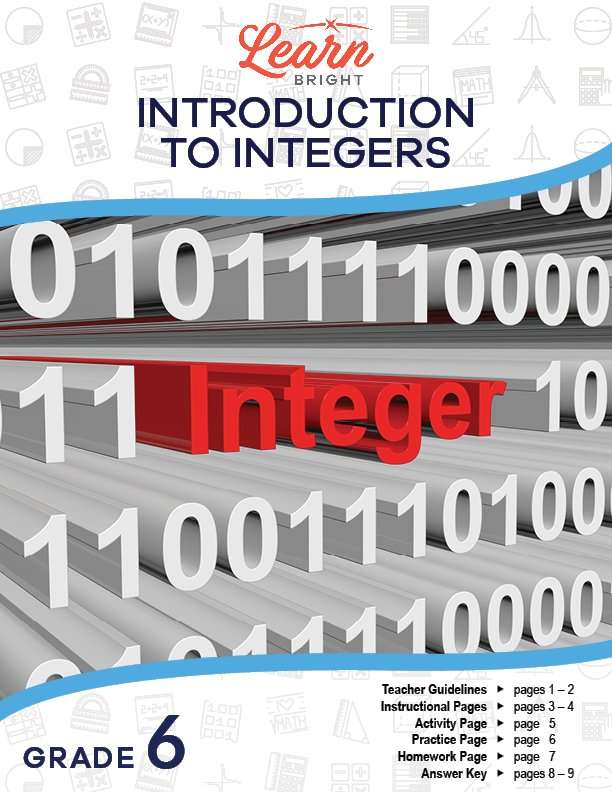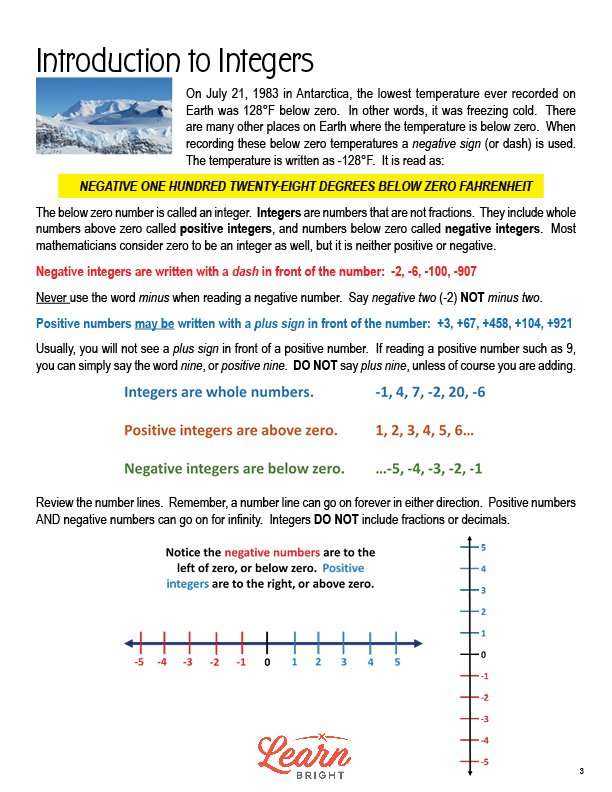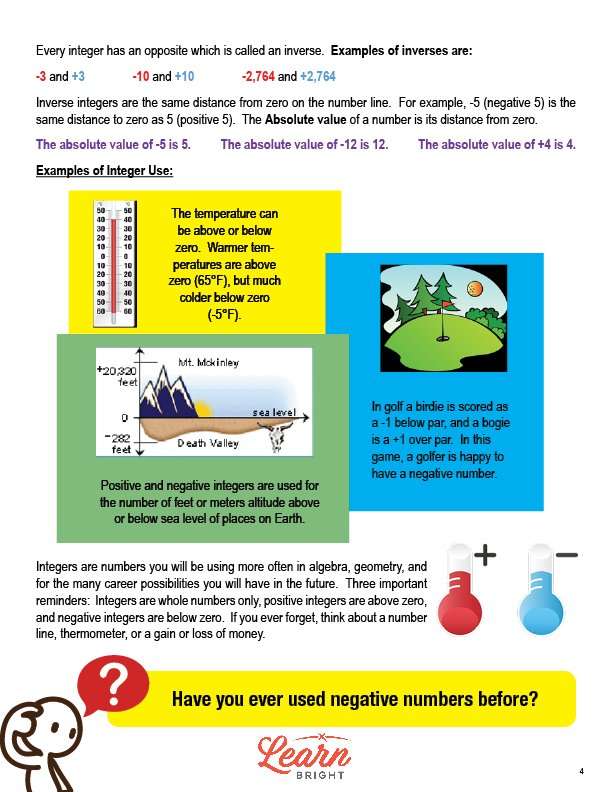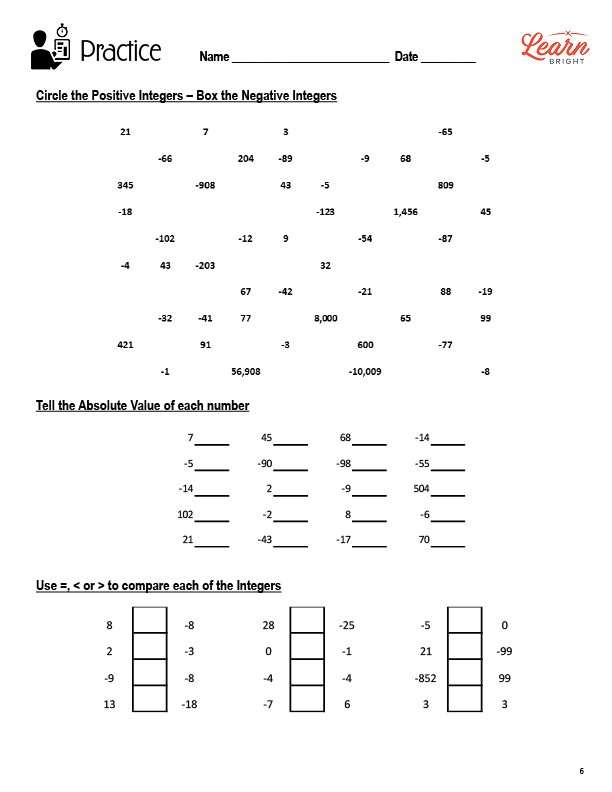Description
What our Introduction to Integers lesson plan includes
Lesson Objectives and Overview: Introduction to Integers equips students to define integer, recognize an integer, identify positive and negative integers on a number line, and name uses for integers. At the end of the lesson, students will be able to define integer, recognize an integer, identify positive and negative integers on a number line, and name uses for integers. This lesson is for students in 6th grade.
Classroom Procedure
Every lesson plan provides you with a classroom procedure page that outlines a step-by-step guide to follow. You do not have to follow the guide exactly. The guide helps you organize the lesson and details when to hand out worksheets. It also lists information in the blue box that you might find useful. You will find the lesson objectives, state standards, and number of class sessions the lesson should take to complete in this area. In addition, it describes the supplies you will need as well as what and how you need to prepare beforehand.
Options for Lesson
Included with this lesson is an “Options for Lesson” section that lists a number of suggestions for activities to add to the lesson or substitutions for the ones already in the lesson.One optional addition to this lesson is to distribute number lines to each student to help them identify positive and negative integers. You can also play integer bingo using cards made up positive and negative integers from one to hundred, with 24 different integers on each card. Finally, you could allow your students to access to the Internet to research more uses of integers.
Teacher Notes
The teacher notes page includes a paragraph with additional guidelines and things to think about as you begin to plan your lesson. This page also includes lines that you can use to add your own notes as you’re preparing for this lesson.
INTRODUCTION TO INTEGERS LESSON PLAN CONTENT PAGES
Introduction to Integers
The Introduction to Integers lesson plan includes two pages of content. The lowest temperature ever recorded on Earth was 128°F below zero. When writing numbers below zero, we use a negative sign (-). Therefore, we write the coldest temperature ever recorded as -128°F. We read it as negative one hundred twenty-eight degrees below zero.
The number -128 is an example of an integer. Integers are numbers that are not fractions, and they include numbers both above and below zero. Numbers above zero are positive integers and numbers below zero are negative integers. Many mathematicians also consider zero to be an integer, even though it isn’t positive or negative.
We write negative integers with a dash (or minus sign) in front of the number. However, we never use the word minus when reading a negative number out loud. Instead, we say negative.
We can, but don’t often, write positive numbers with a plus in front of them. The plus sign is not necessary! When we read positive numbers out loud, we also don’t need to say positive before the number, and we never say plus before the number. We just say the number.
The lesson includes a helpful number line. Number lines can go forever in either direction, because both positive and negative numbers can go on for infinity. On a number line, negative numbers are the left of zero and positive numbers are to the right of zero.
All integers have an opposite, also called an inverse. -3 and 3 are inverses, as are -10 and 10. Inverse integers are the same distance from zero on the number line. -5, for example, is the same distance from zero as 5, just in the opposite direction.
The absolute value of a number is its distance from zero. For example, the absolute value of -5 is 5, the absolute value of -12 is 12, and the absolute value of 4 is 4.
Examples of Integer Use
Next, the lesson includes some examples of integer use in the real world. Temperatures, for example, can be either above or below zero. Warm temperatures (and even some cold temperatures) are above zero, while very cold temperatures are below zero.
If you get a birdie in golf, it’s scored as -1 below par. A bogie is 1 over par. In golf, you actually want a negative score! We also use positive and negative integers for altitude, or the number of feet or meters above or below sea level.
We use integers often in algebra, geometry, and in many careers. Always remember that integers are whole numbers only, positive integers are above zero, and negative integers are below zero.
INTRODUCTION TO INTEGERS LESSON PLAN WORKSHEETS
The Introduction to Integers lesson plan includes three worksheets: an activity worksheet, a practice worksheet, and a homework assignment. You can refer to the guide on the classroom procedure page to determine when to hand out each worksheet.
CARD GAMES ACTIVITY WORKSHEET
Students will work in pairs to solve the activity worksheet. Each pair will use a deck of cards, without face cards, to play four games! For the game, red cards represent negative integers while black cards represent positive integers. Aces count as one. Each time a student wins a game, they keep the winning pair of cards.
For the first game, students take turns drawing cards. Each time, the card with the greatest absolute value (the integer farthest from zero) wins!
For the second game, students take turns drawing cards. Each time, the card with the least absolute value (the integer closest to zero) wins!
For the third game, students again take turns drawing cards. Each time, the card with the least value wins. For example, a red 3 = -3 wins over a black 4 = +4 or a red 7 defeats a red 5 (-7 < -5).
Finally, for the fourth game, students take turns drawing cards. Each time, the card with the greatest value wins!
For each game, any tied cards will be shuffled back into the deck. Games can be timed or students can continue until they run out of cards. The student who has the most cards at the end of the games wins!
INTEGERS PRACTICE WORKSHEET
The practice worksheet asks students to first circle the positive integers in a group of numbers. They will then write down the absolute value of each number listed. Finally, they will use =, <, or > to compare pairs of integers.
INTRODUCTION TO INTEGERS HOMEWORK ASSIGNMENT
For the homework assignment, students will first fill in each blank in a paragraph using the provided word bank. They will also define five terms in their own words.
Worksheet Answer Keys
This lesson plan includes answer keys for the practice worksheet and the homework assignment. If you choose to administer the lesson pages to your students via PDF, you will need to save a new file that omits these pages. Otherwise, you can simply print out the applicable pages and keep these as reference for yourself when grading assignments.









